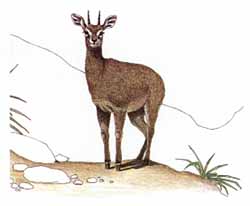English: Klipspringer; French: Oréotrague; Afrikaans: Klipspringer, Klipbokkie; Amharic: Sses; Arabic: Um Digdig; Damara: !!khâses, !!khâises; Hausa: gadar dutse; Iswana: Mokabawane, Kololo; Kikuyu: Kiriga; Kiswahili: Ngurunguru, Mbuzi Lozi, Kashenda mawe; Maasai: Enkine, O Soito; Ovambo: Ongorowe; Shaba: Kipele; Shangan: Ngululu; Shona: Ngururu; Sindebele: Cogo; Somali: Alakud; Turkana: Atirekiki; Xhosa: Igogo; Zulu: Ilogogo.
 |
Former distribution: From Nigeria east to Somalia and south to the Cape; from the Cape north to western Angola.
Present distribution: Northern Nigeria, south-eastern Sudan, central Ethiopia, northern Somalia, north-eastern Uganda, western Kenya, Tanzania, eastern Botswana, western Zaire, Zambia, Malawi, Mozambique; South Africa: Transvaal, Natal, Swaziland, Orange Free State, Cape Province, north to Namibia and south-west Angola.
Behaviour: Preferred habitat: rocky outcrops with bushes up to 4000 m: They live in small family groups; active at twilight; they browse on leaves, herbs, plants and fruits, occasionally they are grazers. Predators include leopards, caracals, jackals, servals and pythons.
Population status: Endangered in Nigeria, Sudan and South Africa (except Krüger Park), Angola, Somalia, Ethiopia; probably stable in all other regions?
Brief notes:
Body weight: 15-18 kg
Head and body length: 90-115 cm
Tail length: 8-13 cm
Shoulder height: 50-60 cm
Gestation period: 214 days
Maximum age: 15 years in captivity
Trophy: Record SCI: 16 2/8 score, 1983 RSA, Dr. MARCIAL G. SEQUEIRA; average 11 score. RW’s: 6 1/4″, South Africa, F.A. GAUDIN; average 4″.
Hunting methods: Stalking.
Subspecies: 11 (ANSELL, 1972) They are listed here, but with the comments from R.H.N. SMITHERS 1983, “the limits within which these subspecies occur, remain uncertain.”
1. O.o. oreotragus (Orange Free State and Cape Province)
2. O.o. saltatixoides (Ethiopia)
3. O.o. somalicus (Somalia)
4. O.o. aureus (Kenya and Uganda)
5. O.o. schillingsi (North Tanzania)
6. O.o. aceratos (Rwanda and central Tanzania)
7. O.o. centralis (South Tanzania, south-eastern Zaire, Zambia)
8. O.o. stevensoni (Zimbabwe and Botswana)
9. O.o. transvaalensis (Transvaal and Natal)
10. O.o. porteousi (Nigeria to Sudan)
11. O.o. tyleri (Namibia and Angola)
Remarks: The records on population status and distribution must be revised; more information needed. Normally only the males carry horns, but in O.o. schillingsi both sexes have horns.






